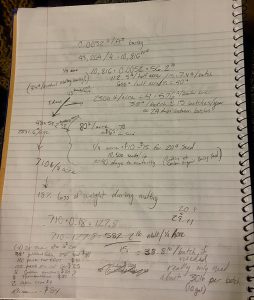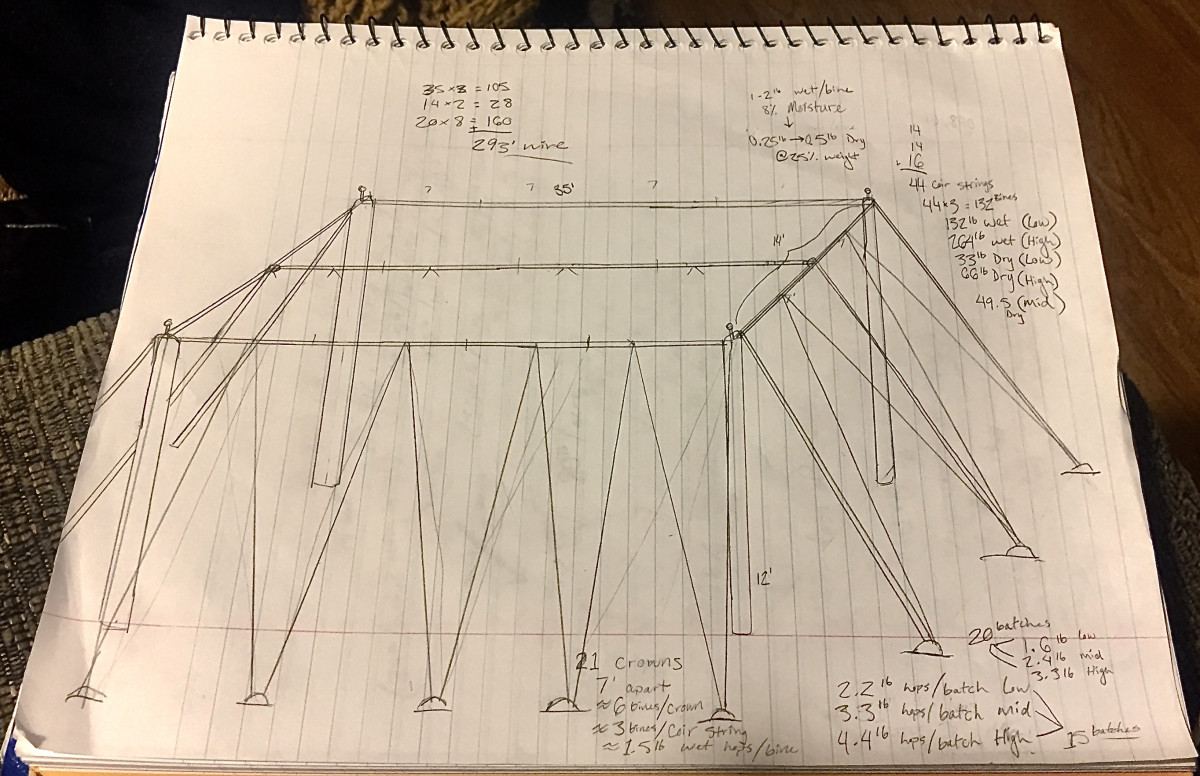Being a self-sufficent home brewer is certainly feasible. The first, and most substantial necessity is land. Only about a half an acre of unused, sunny, flat ground is needed to grow the ingredients for twenty 10 gallon batches of beer. In addition to land, a small grain sprouting machine, and hop/grain kiln are needed (homemade plans for these in an earlier posting).
A trellis system 35′ by 14′ would be needed to properly grow enough hops to have
at least 1.5 pounds per batch. This system consists of 4 raw timber poles measuring 20 feet in length, sunk 5 feet into the ground, for a trellis height of 15 feet. The trellis will be composed of three rows of 3/8″ galvanized wire which will connect to the ground with anchors for support. The sides off the trellis system will also be connected, and anchored to the ground in the same manner. There will be a total of 21 crowns; 5 in each row and three one either side. Each crown should have 6 strong bines selected, with 3 bines per coir string. The two side crowns in the middle row will have 9 bines selected, as it will have 3 coir strings to climb. The amount of training coir will total 44 strings, and 132 bines.
Each bine will ideally produce 1-2 pounds of wet hops. When properly dried to about 8% moisture the hops will lose approximately 75% of their weight for an ideal dry weight of 0.25-0.5lb/bine. With these numbers a low total dry weight would be 33lbs, a mid level dry weight would be 49.5lbs and a high dry weight would be 66lbs. These totals would allow 1.6lbs/batch (low), 2.4lbs/batch (mid), and 3.3lbs/batch (high) for twenty 10 gallon batches throughout the year.
Materials Needed:
- (4) 20′ raw timber hardwood posts- $200
- (300′) 3/8″ galvanized cable- $80
- (100 pack) hop clips- $10
- (100 pack) pre-cut coir- $25
- (8) cable anchors- $80
- (8) turnbuckles- $80
- (2) cable connectors- $4
- (21) Rhizomes- $84
Total: $563
An irrigation system is not necessary at this scale, but would prove helpful, especially if this plot could be added to an existing system. In addition to these materials, pesticides and fungicides are needed; either organic or not. It will not be until the third year that a full crop is produced, this level of production will continue for at least 20 years if maintained.
Barley is luckily an easy crop to raise compared to the hassle of hops. Ideally around 59.2 bushels an acre can be produced if seeded properly. With a bushel of  barley weighing 48 pounds an acre amounts to a total of 2841.6 pounds. This would mean that for twenty 10 gallon batches, only a quarter acre is necessary. With a 1/4 acre cultivated ~710lbs of malting barley can be grown. 582.2lbs of malted barley can be produced with this amount of land, accounting for the 18% weight loss through the malting process. This amount allows 29.11 pounds per 10 gallon batch. Besides normal land prep, tilling, and watering the only necessary cost is about $15 for 20 pounds of seed.
barley weighing 48 pounds an acre amounts to a total of 2841.6 pounds. This would mean that for twenty 10 gallon batches, only a quarter acre is necessary. With a 1/4 acre cultivated ~710lbs of malting barley can be grown. 582.2lbs of malted barley can be produced with this amount of land, accounting for the 18% weight loss through the malting process. This amount allows 29.11 pounds per 10 gallon batch. Besides normal land prep, tilling, and watering the only necessary cost is about $15 for 20 pounds of seed.
This simplistic plan allows for more than enough ingredients in case of improper growing, and handling. Small scale, inexpensive pellet mills are also available for ensuring product stability, and quality throughout the year.
